DRAMA/THEATRE
PAPER – III
Note : This paper contains seventy five (75) objective type questions of two (2) marks each. All questions are compulsory.
1. Match the items in List-I with those in List-II :


2. Assertion (A) : Performers wore masks and character appropriate dress, sang, chanted and danced much of the text. A group of performers formed a chorus and men played both male and female roles. This was the tradition of the Greek theatre.
Reason (R) : These conventions suggest that performance in the Greek theatre was highly informal.
Codes :
(1) (A) true and (R) false.
(2) (A) false and (R) true.
(3) Both (A) and (R) false.
(4) Both (A) and (R) true.
3. Give the correct sequence of the following Directors of National School of Drama from latest to former :
(1) Waman Kendre, Anuradha Kapoor, Devendra Raj Ankur, Ram Gopal Bajaj
(2) Waman Kendre, Ram Gopal Bajaj, Devendra Raj Ankur, Anuradha Kapoor
(3) Waman Kendre, Devendra Raj Ankur, Ram Gopal Bajaj, Anuradha Kapoor
(4) Waman Kendre, Anuradha Kapoor, Ram Gopal Bajaj, Devendra Raj Ankur
4. Pick the odd one out :
(1) Pava kathakali
(2) Putul Nach
(3) Kathputli
(4) Gambuh
5. Who wrote ‘La Mandragola’ a satiric masterpiece ?
(1) Ariosto
(2) Machiavelli
(3) Giovanni Battista Guarini
(4) Plautus
6. Match the items in List-I with those in List – II :


7. Assertion (A) : For Habib Tanveer the real “Theatre People” exists in village and has to brought to the educated because the educated lack the culture which the massess of villages possess so richly though they are illiterate.
Reason (R) : The rural forms should reach the city, urban drama must also return to hinterland to complete the transformation of drama-audience relation in both the locations.
Codes :
(1) Both (A) and (R) false.
(2) Both (A) and (R) true.
(3) (A) true, (R) false.
(4) (A) false, (R) true.
8. Give the correct sequence in the context of geographical origin from North to South :
(1) Ramleela, Ramkein, Legong, Sandiwara
(2) Ramleela, Ramkein, Sandiwara, Legong
(3) Legong, Sandiwara, Ramkein, Ramleela
(4) Sandiwara, Ramleela, Legong, Ramkein
9. Pick the odd one out in context of Absurd drama.
(1) Edward Elbee
(2) Harold Pinter
(3) J.B. Priestly
(4) Samuel Beckett
10. It is a small incident in a dramatic plot which is intended only to further the development of the main plot :
(1) Vimarsha
(2) Chulikā
(3) Prakari
(4) Phalāyoga
11. Match the items in List – I with those in List – II :

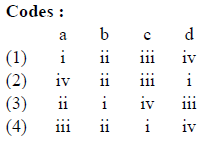
12. Assertion (A) : The Chinese opera style was adopted by the Vietnamese court opera, Hat Boi. But despite such influences, Hat Boi represents indigenous tradition.
Reason (R) : A Vietnamese ruler of early eleventh century employed a Chinese actor to teach his court actors the art of Chinese satirical theatre.
Codes :
(1) Both (A) and (R) true.
(2) Both (A) and (R) false.
(3) (A) true, (R) false.
(4) (A) false, (R) true.
13. Pick the correct sequence of the following theatre concepts of west according to their evolution in ascending order :
(1) The Secular Theatre, The Ritual Theatre, The Public Theatre, The Pageant Theatre.
(2) The Ritual Theatre, The Secular Theatre, The Pageant Theatre, The Public Theatre.
(3) The Ritual Theatre, The Pageant Theatre, The Public Theatre, The Secular Theatre.
(4) The Secular Theatre, The Ritual Theatre, The Pageant Theatre, The Public Theatre.
14. Trace the odd among the following :
(1) Vikrushta
(2) Chaturasra
(3) Vritta
(4) Tryasra
15. The proscenium arch, popular in court performances in the Royal era, was first developed
(1) in Italy during the Renaissance
(2) in the French Court
(3) by Shakespeare in England
(4) in the Spanish theatre
16. Match the items in List – I with those in List – II :

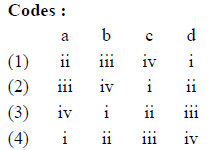
17. Assertion (A) : Andre Antoine laid the foundation for “non-realistic” acting in the theatre.
Reason (R) : He said that the spectators are not interested in the physical actions of men to the same extent as they are interested in the “causes” of these actions.
Codes :
(1) Both (A) and (R) true.
(2) Both (A) and (R) false.
(3) (A) true, (R) false.
(4) (A) false, (R) true.
18. Give the correct sequence of the following Avasthās in descending order :
(1) Prārambha, Niyatā-phalaprapti, Phalayoga, Prayatna, Prāptisambhava
(2) Phalayoga, Niyatā Phalaprapti, Praptisambhava, Prayatna Prārambha
(3) Phalayoga, Prayatna, Prāptisambhava, Niyatā Phalaprapti, Prārambha
(4) Prārambha, Prayatna, Prāptisambhava, Niyatā Phalaprapti, Phalayoga
19. Pick the odd one out :
(1) Comedia de Santo
(2) Comedie – Francaise
(3) Comedia de fabrica
(4) Alta Comedia
20. The play ‘Simhasan Khali Hai’ is written by
(1) Ajay Shukla
(2) Sushil Kumar Singh
(3) Ajghar Wajahat
(4) Surendra Verma
21. Match the items in List – I with List – II :


22. Assertion (A) : Nātyashāstra views theatre primarily as a recreational, leisure-time activity resembling a game or sport.
Reason (R) : Its main function is to refresh a person’s mind, to free him from the worries, care and sorrow which burdens it in following the routine of daily existence.
Codes :
(1) Both (A) and (R) are false.
(2) (A) true, (R) false.
(3) Both (A) and (R) are true.
(4) (A) false, (R) true.
23. Find out the correct order in the development of the ‘Epic theatre’ :
(1) Bertott Brecht, Max Reinhardt, Erwin Piscator, Augusta Boal
(2) Max Reinhardt, Erwin Piscator, Bertott Brecht, Augusto Boal
(3) Erwin Piscator, Max Reinhardt, Bertott Brecht, Augusto Boal
(4) Max Reinhardt, Bertott Brecht, Augusto Boal, Erwin Piscator
24. Trace the odd one out :
(1) Rangvarta
(2) Rang Prasang
(3) Samkaleen Rangmunch
(4) Rangayana
25. Gambhira is an ancient folk theatre form of
(1) Gujarat
(2) Punjab
(3) Bengal
(4) Assam
26. Match the items in List – I with those in List – II :

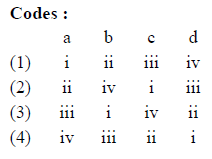
27. Assertion (A) : According to Richard Schechner, theatre itself is part of larger environments outside the theatre. These larger out-of-the theatre spaces are the life of the city; and also temporal-historical spaces-modalities of time/space.
Reason (R) : The first scenic principle of environmental theatre, is to create and use whole spaces.
Codes :
(1) Both (A) and (R) false.
(2) Both (A) and (R) true.
(3) (A) false and (R) true.
(4) (A) true and (R) false.
28. Give the correct sequence of the following theatre personalities in chronological order :
(1) Sisir Bhaduri, Girish Chandra Ghosh, Sombhu Mitra, Rudra Prasad Sen Gupta
(2) Girish Chandra Ghosh, Sisir Bhaduri, Sombhu Mitra, Rudra Prasad Sen Gupta
(3) Sombhu Mitra, Rudra Prasad Sen Gupta, Girish Chandra Ghosh, Sisir Bhaduri
(4) Rudra Prasad Sen Gupta, Sombhu Mitra, Sisir Bhaduri, Girish Chandra Ghosh
29. Pick the festival which is not associated with the folk or traditional theatres and dances of India.
(1) Chaitra Parva Festival
(2) Konark Festival
(3) Saptak Festival
(4) Kalidas Samaroh
30. The dialogue in David Mamet’s plays is famous for its
(1) Inclusion of multiple languages
(2) Classical aphorisms
(3) Silence
(4) Use of fragmented everyday speech
31. Match the items in List-I with those in List-II :


32. Assertion (A) : According to Adya Rangacharya, the post-epic Suta transformed the epic recitation into regular dramatic representation, himself becoming Sutradhara.
Reason (R) : In modern Indian theatre the functions of Sutradhara can be seen at multilevels. He not only introduces the play but also raise certain issues which are to be discussed in the total scheme of the play.
Codes :
(1) (A) true, (R) false.
(2) (A) false, (R) true.
(3) Both (A) and (R) false.
(4) Both (A) and (R) true.
33. Give the correct sequence in the context of geographical origin from East to West.
(1) Kabuki, Hatboi, Yokthe Pwe, Bhagavatmela
(2) Bhagavatmela, Yokthe Pwe, Hatboi, Kabuki
(3) Yokthe Pwe, Hatboi, Bhagavatmela, Kabuki
(4) Kabuki, Bhagavatmela, Hatboi, Yokthe Pwe
34. Pick the odd one out :
(1) Tempo Rhythm
(2) Communion
(3) Truth and Belief
(4) Method of Physical Action
35. It is a dramatic device of turning the back on the characters on the stage to indicate a secret :
(1) Karne
(2) Apavāritaka
(3) Ātmagata
(4) Prakāsha
36. Match the items in List – I with those in List – II :

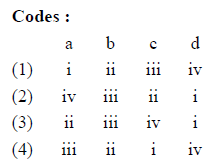
37. Assertion (A) : The end of the 19th century in South-East Asian theatre was a period of emerging patriotism and nationalism and the new kind of realistic spoken theatre.
Reason (R) : The new kind of theatre was exploited not only to strengthened national identity but in some cases to propagate completely new political ideologies.
Codes :
(1) Both (A) and (R) true.
(2) Both (A) and (R) false.
(3) (A) true, (R) false.
(4) (A) false, (R) true.
38. Choose the correct sequence of the following characters in order of their appearance in Chekhov’s ‘The Cherry Orchard’ :
(1) Dunyasha, Anya, Lopahin, Varya
(2) Lopahin, Dunyasha, Varya, Anya
(3) Dunyasha, Lopahin, Varya, Anya
(4) Lopahin, Dunyasha, Anya, Varya
39. Trace the odd one out :
(1) Bhāna
(2) Vithi
(3) Dima
(4) Goshthi
40. A revolving stage with, usually, two sections, one rotating inside the other is called :
(1) Revolving stage
(2) Concentric revolving stages
(3) Compound curves
(4) Double whip
41. Match the items in List – I with those in List – II :

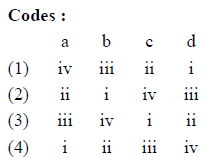
42. Assertion (A) : The “poor theatre” concept of Jerzy Grotowski focused on making voices and bodies of the actors as primary source of spectacle on stage.
Reason (R) : The words and ideas of playwright were another major focus of Grotowski.
Codes :
(1) Both (A) and (R) true.
(2) Both (A) and (R) false.
(3) (A) true, (R) false.
(4) (A) false, (R) true.
43. Give the correct sequence of the following elements of drama as enumerated by Bharata while taking them from each Veda :
(1) Rasa, Abhinaya, Pāthya, Geet
(2) Geet, Pāthya, Rasa, Abhinaya
(3) Pāthya, Geet, Abhinaya, Rasa
(4) Rasa, Pāthya, Geet, Abhinaya
44. Trace the odd one out in context of ‘Theatre of Oppressed’ :
(1) Paolo Freire
(2) Augusto Boal
(3) Mady Schutzman
(4) Eugenio Barba
45. The present chairman of Sangeet Natak Academy is
(1) Kirti Jain
(2) Leela Samson
(3) Sekhar Sen
(4) Naga Bhushana Sarma
46. Match the items in List – I with List – II :

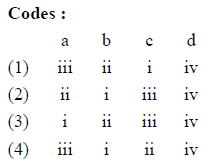
47. Assertion (A) : Sanskrit drama was primarily literature to be read rather than to be performed.
Reason (R) : Sanskrit drama was full of poetic descriptions which cannot be enacted on the stage.
(1) (A) is true, (R) is false.
(2) Both (A) and (R) are false.
(3) (A) is false, (R) is true.
(4) Both (A) and (R) are true.
48. Find out the correct order in the development of following concepts in theatre :
(1) Elements of an action, Fantastic Realism, Suzuki Method, Theatre of Images
(2) Theatre of Images, Suzuki Method, Elements of an action, Fantastic Realism
(3) Elements of an action, Theatre of Images, Suzuki Method, Fantastic Realism
(4) Fantastic Realism, Elements of an action, Theatre of Images, Suzuki Method
49. Trace the odd one out :
(1) Inder Sabha
(2) Ajatashatru
(3) Skandagupta
(4) Dhruvaswamini
50. Doddata, Indian form of North and northeast Karnatak, is also known as
(1) P’ansori
(2) Angura
(3) Bayalata
(4) Palanata
51. Match the items in List – I with those in List – II :


52. Assertion (A) : The key light is the brightest light on the scene, and the fill light is used to fill the shadows created by the key light.
Reason (R) : The terms key light and fill light are frequently used to describe the relationship between the direction and relative intensity of light striking an object.
Codes :
(1) (A) true and (R) false.
(2) Both (A) and (R) false.
(3) (A) false and (R) true.
(4) Both (A) and (R) true.
53. Give the correct sequence of the following plays of Bhishma Sahani in chronological order :
(1) Hanush, Kabir Khara Bazar Me, Muvavze, Madhavi
(2) Madhavi, Kabir Khara Bazar Me, Muvavze, Hanush
(3) Hanush, Kabir Khara Bazar Me, Madhavi, Muvavze
(4) Muvavze, Madhavi, Kabir Khara Bazar Me, Hanush
54. Pick the odd one out :
(1) Wayang Golek
(2) Lakhon Sback
(3) Yokthe Pwe
(4) Kabuki
55. Which playwright was responsible for introducing realism in Europe ?
(1) George Bernard Shaw
(2) Henrik Ibsen
(3) Jean Racine
(4) Arthur Miller
56. Match the items in List – I with those in List – II :


57. Assertion (A) : The practice in traditional theatre is guided by a set of conventions and the nature of stylization.
Reason (R) : Traditional forms, as embodying performance texts, dramatic texts, techniques, movement patterns and codified gestures that have been handed down from generation to generation, are an integral part of the Indian way of life.
Codes :
(1) Both (A) and (R) true.
(2) Both (A) and (R) false.
(3) (A) true, (R) false.
(4) (A) false, (R) true.
58. Indicate the correct sequence in the context of geographical origin from East to West.
(1) Danda Nata, Alkap, Ojhapali, Nata Sankeertan
(2) Nata Sankeertan, Ojhapali, Alkap, Dandanata
(3) Nata Sankeertan, Danda nata, Ojhapali, Alkap
(4) Alkap, Ojhapali, Danda Nata, Nata Sankeertan
59. Pick the odd one out :
(1) Viola Spolin
(2) Keith Johnstone
(3) Stella Adler
(4) John Millington Synge
60. It is a verbal mode of dramatic presentation :
(1) Kaishiki
(2) Bhārati
(3) Ārabhati
(4) Sāttvati
61. Match the items in List – I with those in List – II :


62. Assertion (A) : In the Indian Folk Theatre, the Sutradhara is known by different names in different regional varieties.
Reason (R) : Sutradharas hold most important position in the entire scheme of the folk play.
Codes :
(1) Both (A) and (R) true.
(2) Both (A) and (R) false.
(3) (A) true, (R) false.
(4) (A) false, (R) true.
63. Give the correct sequence of the following Western Playwrights in order of their appearance in theatre :
(1) Moliere, Jean Racine, Alexander Pushkin, Victor Hugo
(2) Jean Racine, Moliere, Alexander Pushkin, Victor Hugo
(3) Moliere, Alexander Pushkin, Jean Racine, Victor Hugo
(4) Jean Racine, Moliere, Victor Hugo, Alexander Pushkin
64. Trace the odd one out :
(1) Svagata
(2) Janāntika
(3) Culikā
(4) Karne
65. Out of the following plays, which one was not directed by Peter Brook ?
(1) A Midsummer Night’s Dream
(2) Orghast
(3) The Conference of the Birds
(4) The Bacchae
66. Match the items in List – I with those in List – II :


67. Assertion (A) : According to Aristotle the primary objective of tragedy is to arouse fear and pity in the audience.
Reason (R) : He also stated that tragedy represents the consequences of deviant behaviour.
Codes :
(1) Both (A) and (R) true.
(2) Both (A) and (R) false.
(3) (A) true, (R) false.
(4) (A) false, (R) true.
68. Give the correct sequence of the following Rasa as described in the sixth Chapter of Nātyashāstra :
(1) Shringāra, Hāsya, Karuna, Raudra, Vira
(2) Vira, Karu. na, Raudra, Shringāra, Hāsya
(3) Hāsya, Vira, Karuna, Raudra, Shringāra
(4) Raudra, Shringāra, Hāsya, Karuna, Vira
69. Pick the odd one out :
(1) Carbon Microphone
(2) Crystal Microphone
(3) Condenser Microphone
(4) Dynamo Microphone
70. The book ‘Theatre of the Earth’ published by Seagull books is based on the works of
(1) B.V. Karanth
(2) K.N. Panikker
(3) Kanhailal
(4) Ratan Thiyam
71. Match the items in List – I with List – II :

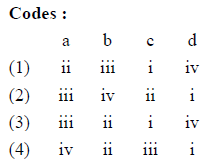
72. Assertion (A) : According to western scholars Rasa does not lie in the art object (the performance) nor is it rooted in one’s personal responses to a play.
Reason (R) : Rasa is neither objective nor subjective; it is rather the process of aesthetic perception itself.
Codes :
(1) (A) is true, (R) is false.
(2) (A) is false, (R) is true.
(3) Both (A) and (R) are true.
(4) Both (A) and (R) are false.
73. Choose the correct sequence of the following theatre personalities according to their country of origin from East to West :
(1) Nemirovich Denchenko, Gordon Craig, Richard Schechner, Tadeusz Kantor
(2) Tadeusz Kantor, Nemirovich Denchenko, Richard Schechner, Gordon Craig
(3) Gordon Craig, Richard Schechner, Tadeusz Kantor, Nemirovich Denchenko
(4) Nemirovich Denchenko, Tadeusz Kantor, Gordon Craig, Richard Schechner
74. Trace the odd man out :
(1) Asghar Wazahat
(2) Swadesh Deepak
(3) Mani Madhukar
(4) Robin Das
75. Shumang Lila is a folk theatre form of
(1) Rajasthan
(2) Manipur
(3) Assam
(4) Uttar Pradesh
Latest Govt Job & Exam Updates: